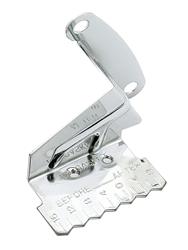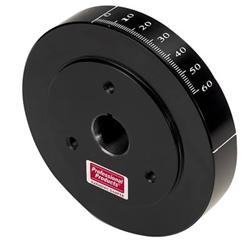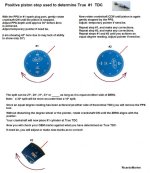shaunleveque
New member
Hi All,
I have a timing problem that is really"doing my crust" that I just can't fathom, so any help is greatly appreciated.
I posted a problem in 2010 regarding problems with my Volvo Penta AQ211A, which you helped me sort out. That engine has since gone to the scrapyard.
I have fitted a recon Volvo Penta AQ211A to my boat, but have never been able to get the timing "right".
My apologies if this is long-winded, but I know that in order for anyone to help I'll need to tell the whole story.
The original AQ211A engine destroyed itself after being winterised for over 2 years (I have some interesting photo's, but that's another story).
So,I bought a reconditioned engine, complete with cylinder heads from an Ebay marine engine reconditioning company. I believe the block was new (at least, that's what they told me). The heads were re-conditioned ones.
A lot of parts from the original engine were swapped over, including the carb (now replaced), distributor,cam-chain timing cover, pulleys, Exhaust and inlet manifolds.
However, I had to use the harmonic balancer from a slightly newer engine, and I believe it's from an automobile. But, the key-way and TDC marks were in the same places as the original.
My problem is the ignition timing. But it's NOT as simple (or maybe it is) as it first appears.
So, I rotated the engine and found TDC. No1 piston at the top, valves closed, rotor arm pointing at No1 lead.
Checked firing order (several times), as far as I can see everything "static" is correct.
So, now is where it gets weird...... The engine refused to start, so I rotated the distributor until it fired-up,checked the timing (should be 6 Deg BTDC @ 750 RPM) but found that it was *initially* at around 16 - 18 Deg BTDC.
If I reset the timing while it's running (using an advancing timing light - a brand new one) to 6 Deg,the engine runs rough. At this point, if I open the throttle it mis-fires through the carb and stalls.
So, I set the timing"by ear". When I do this, ignoring timing marks, I can get the engine running sweetly, instant response on the throttle,easy starting, no misfiring, steady idle, all as you would expect.
And this is where it gets really really weird! ....Iput the timing light back on and dialled-in until I could see what the timing actually is. It appears to be: 20 Deg BTDC @ 750 RPM(should be 6 Deg) and 34 Deg BTDC @ 2500 RPM (should 14 Deg BTDC)according to the cam-chain cover marks. (using the deepest V as the TDC mark).
I confirmed this (as best I can) with a standard non-advancing timing light, several times.
I suspected something somewhere is way "out-of-whack", so I stripped the entire HT ignition setup down, started from scratch, one lead at a time,re-confirmed firing order, rotation of rotar-arm (clockwise). Still the same!
So, I stripped the distributor. The distributor is a Prestolite (I think) but the points have been changed for an electronic (hall effect) pickup. Centrifugal weights move freely (cleaned and lightly re-greased pivot-points anyway), springs are intact and firm, everything appears to operate as expected. (No vacuum advance on these things).
But,still the timing appears to be "way off their marks".
Someone suggested "Well, if you've done it by ear and it runs, close it up and forget it!", but that doesn't work for me.
I want to know that the timing is as accurate as I can get it. Besides, I just can't get my head around why the timing can appear to be so far off the marks, and run infinitely better than if it's "timed correctly".
Could it be something to do with the hall effect "points"? Is it possible the cam-chain cover from the original engine has the timing marks in the wrong place for this engine? (They are on the right-hand side, down between the cooling hoses).
Did the V8 ever have timing marks in a different position (more round to the left-hand side)? Maybe if the block was originally an automobile engine? Or, maybe the block would normally be used by a different boat builder and would normally have a different cam-chain cover?
I have no idea what the origins of this block are.
Am I being stupid and missing something fundamentally simple?
Any help is greatly appreciated.
I have a timing problem that is really"doing my crust" that I just can't fathom, so any help is greatly appreciated.
I posted a problem in 2010 regarding problems with my Volvo Penta AQ211A, which you helped me sort out. That engine has since gone to the scrapyard.
I have fitted a recon Volvo Penta AQ211A to my boat, but have never been able to get the timing "right".
My apologies if this is long-winded, but I know that in order for anyone to help I'll need to tell the whole story.
The original AQ211A engine destroyed itself after being winterised for over 2 years (I have some interesting photo's, but that's another story).
So,I bought a reconditioned engine, complete with cylinder heads from an Ebay marine engine reconditioning company. I believe the block was new (at least, that's what they told me). The heads were re-conditioned ones.
A lot of parts from the original engine were swapped over, including the carb (now replaced), distributor,cam-chain timing cover, pulleys, Exhaust and inlet manifolds.
However, I had to use the harmonic balancer from a slightly newer engine, and I believe it's from an automobile. But, the key-way and TDC marks were in the same places as the original.
My problem is the ignition timing. But it's NOT as simple (or maybe it is) as it first appears.
So, I rotated the engine and found TDC. No1 piston at the top, valves closed, rotor arm pointing at No1 lead.
Checked firing order (several times), as far as I can see everything "static" is correct.
So, now is where it gets weird...... The engine refused to start, so I rotated the distributor until it fired-up,checked the timing (should be 6 Deg BTDC @ 750 RPM) but found that it was *initially* at around 16 - 18 Deg BTDC.
If I reset the timing while it's running (using an advancing timing light - a brand new one) to 6 Deg,the engine runs rough. At this point, if I open the throttle it mis-fires through the carb and stalls.
So, I set the timing"by ear". When I do this, ignoring timing marks, I can get the engine running sweetly, instant response on the throttle,easy starting, no misfiring, steady idle, all as you would expect.
And this is where it gets really really weird! ....Iput the timing light back on and dialled-in until I could see what the timing actually is. It appears to be: 20 Deg BTDC @ 750 RPM(should be 6 Deg) and 34 Deg BTDC @ 2500 RPM (should 14 Deg BTDC)according to the cam-chain cover marks. (using the deepest V as the TDC mark).
I confirmed this (as best I can) with a standard non-advancing timing light, several times.
I suspected something somewhere is way "out-of-whack", so I stripped the entire HT ignition setup down, started from scratch, one lead at a time,re-confirmed firing order, rotation of rotar-arm (clockwise). Still the same!
So, I stripped the distributor. The distributor is a Prestolite (I think) but the points have been changed for an electronic (hall effect) pickup. Centrifugal weights move freely (cleaned and lightly re-greased pivot-points anyway), springs are intact and firm, everything appears to operate as expected. (No vacuum advance on these things).
But,still the timing appears to be "way off their marks".
Someone suggested "Well, if you've done it by ear and it runs, close it up and forget it!", but that doesn't work for me.
I want to know that the timing is as accurate as I can get it. Besides, I just can't get my head around why the timing can appear to be so far off the marks, and run infinitely better than if it's "timed correctly".
Could it be something to do with the hall effect "points"? Is it possible the cam-chain cover from the original engine has the timing marks in the wrong place for this engine? (They are on the right-hand side, down between the cooling hoses).
Did the V8 ever have timing marks in a different position (more round to the left-hand side)? Maybe if the block was originally an automobile engine? Or, maybe the block would normally be used by a different boat builder and would normally have a different cam-chain cover?
I have no idea what the origins of this block are.
Am I being stupid and missing something fundamentally simple?
Any help is greatly appreciated.
Last edited:




